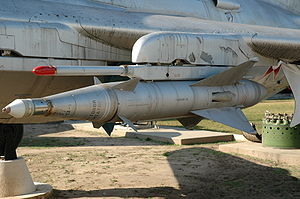avia.wikisort.org - Weapon
The Kaliningrad K-5 (NATO reporting name AA-1 Alkali), also known as RS-1U or product ShM, was an early Soviet air-to-air missile.
This article relies largely or entirely on a single source. (March 2013) |
| K-5 AA-1 Alkali | |
|---|---|
 K-5M | |
| Type | Short-range air-to-air missile |
| Place of origin | Soviet Union |
| Service history | |
| In service | 1957-1977 |
| Used by | Soviet Air Force |
| Production history | |
| Manufacturer | Kaliningrad Series Production Plant |
| Variants | K-55 |
| Specifications | |
| Mass | 82.7 kg (182 lb) |
| Length | 2.49 m (8 ft 2 in) |
| Diameter | 200 mm (7.9 in) |
| Warhead | High explosive |
| Warhead weight | 13 kg (29 lb) |
| Engine | Rocket |
Operational range | 2 to 6 kilometres (1.2 to 3.7 mi) |
| Maximum speed | 2,880 km/h (1,790 mph) (Mach 2.33) |
Guidance system | beam riding |
Launch platform | MiG-17, MiG-19, MiG-21, Su-9 |
History
The development of the K-5 began in 1951. The first test firings were in 1953. It was tested (but not operationally carried) by the Yakovlev Yak-25. The weapon entered service as the Grushin/Tomashevich (Russian: Грушин/Томашевич) RS-2U (also known as the R-5MS or K-5MS) in 1957. The initial version was matched to the RP-2U (Izumrud-2) radar used on the MiG-17PFU, MiG-19PM. An improved variant, K-5M or RS-2US in PVO service, entered production in 1959, matched to the RP-9/RP-9U (Sapfir) radar of the Sukhoi Su-9. The People's Republic of China developed a copy under the designation PL-1, for use by their J-6B fighters.
The difficulties associated with beam-riding guidance, particularly in a single-seat fighter aircraft, were substantial, making the 'Alkali' primarily a short-range anti-bomber missile. Around 1967 the K-5 was replaced by the K-55 (R-55 in service), which replaced the beam-riding seeker with the semi-active radar homing or infrared seekers of the K-13 (AA-2 'Atoll'). The weapon was 7.8 kg (17 lb) heavier than the K-5, but had a smaller 9.1 kg (20 lb) warhead. The K-55 remained in service through about 1977, probably being retired with the last of the Sukhoi Su-9 interceptors.
Specifications (RS-2US / K-5MS)
- Length: 2,500 mm (8 ft 2 in)
- Wingspan: 654 mm (2 ft 1.7 in)
- Diameter: 200 mm (7+7⁄8 in)
- Launch weight: 82.7 kg (182 lb)
- Speed: 800 m/s (2,880 km/h; 1,790 mph)
- Range: 2–6 km (1+1⁄4–3+3⁄4 mi)
- Guidance: beam riding
- Warhead: 13.0 kg (28.7 lb)
Operators

Current Operator
North Korea
Used on MiG-21PFM.
Former operators
 Soviet Union
Soviet Union- Both the Soviet Air Force (VVS) and the Soviet Air Defence Forces (PVO) operated the K-5.
 China
China- The People's Liberation Army Air Force operated licensed Chinese copy of Kaliningrad K-5 designated as PL-1 (PL: short for Pi Li or Pili, meaning thunderbolt).
 Czechoslovakia
Czechoslovakia- The Czechoslovakian Air Force operated RS-2U and RS-2US.
 Hungary
Hungary- The Hungarian Air Force operated RS-2US on MiG-19PMs, MiG-21PFs and MiG-21MFs.
 Mali
Mali- Malian Air Force[1]
 Poland
Poland- The Polish Air Force operated RS-2US on MiG-19PMs and MiG-21s, still in use as practice target.[2]
 Romania
Romania- Locally produced A-90 copy by Electromecanica Ploiesti (1984)
See also
- List of missiles
References
- Citations
- Cooper et al. 2011, p. 47
- SRCP-WR z ITWL. pl.
- Bibliography
- Cooper, Tom; Weinert, Peter; Hinz, Fabian; Lepko, Mark (2011). African MiGs, Volume 2: Madagascar to Zimbabwe. Houston: Harpia Publishing. ISBN 978-0-9825539-8-5.
- Gordon, Yefim (2004). Soviet/Russian Aircraft Weapons Since World War Two. Hinckley, England: Midland Publishing. ISBN 1-85780-188-1.
External links
- RS-2U - Air-to-Air missile at aviation.ru
- K-5 at airwar.ru
- (in Russian)K-5 at missiles.ru
- - Electromecanica website: Air-to-Air missile
На других языках
[de] Kaliningrad K-5
Die Kaliningrad K-5 (NATO-Codename AA-1 „Alkali“), auch bekannt als RS-1U oder Erzeugnis (Isdelije) SchM, war ein leitstrahlgeführter sowjetischer Luft-Luft-Lenkflugkörper.[1]- [en] K-5 (missile)
[fr] Kaliningrad K-5
Le Kaliningrad K-5 (nom de code OTAN : AA-1 « Alkali »), aussi connu sous le nom de RS-1U ou « produit ShM » (en russe : « ШМ », ShM, « boule de feu ») était un ancien missile air-air à courte portée d'origine soviétique. Il fut l'un des tout-premiers mis en service au sein du bloc soviétique.[it] K-5
Il K-5 (anche conosciuto come RS-1U) e derivati, noto in Occidente con il nome in codice NATO di AA-1 Alkali[1], è un missile aria-aria (in inglese: AAM - Air to Air Missile) di sviluppo e fabbricazione sovietica.[ru] К-5 (ракета)
К-5 (РС-1У — реактивный снаряд первый управляемый[2] или Изделие ШМ, по классификации МО США и НАТО: AA-1 Alkali — «Щелочь») — советская управляемая ракета класса «воздух-воздух» с радиокомандной системой наведения. Разработана в ОКБ-2 МАП СССР, под руководством Д. Л. Томашевича. Разработка К-5 началась в 1951 году.Другой контент может иметь иную лицензию. Перед использованием материалов сайта WikiSort.org внимательно изучите правила лицензирования конкретных элементов наполнения сайта.
WikiSort.org - проект по пересортировке и дополнению контента Википедии